Lessico
Pierre Sonnerat
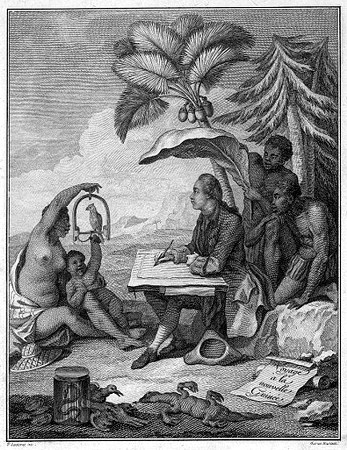
Pierre
Sonnerat all'ombra di una palma studia un pappagallo
che gli è mostrato da una donna della Nuova Guinea
da Voyage à la Nouvelle Guinée - 1776
Pierre
Sonnerat (Lione 18 agosto 1749 – Parigi 31 marzo 1814) è stato un naturalista ed
esploratore francese, nipote di Pierre Poivre![]() , botanico. Fece numerosi viaggi
nell'Asia sud-orientale, soprattutto con lo scopo di ottenere degli esemplari
di piante produttrici di spezie, per contrastare il monopolio olandese del
loro commercio.
, botanico. Fece numerosi viaggi
nell'Asia sud-orientale, soprattutto con lo scopo di ottenere degli esemplari
di piante produttrici di spezie, per contrastare il monopolio olandese del
loro commercio.
Fa inoltre un viaggio in Nuova Guinea, nelle isole Molucche ma anche a Manila, dal 1769 al 1772, durante il quale descrive numerose specie vegetali e animali (il suo diario di viaggio - Voyage à la Nouvelle Guinée - viene pubblicato nel 1776).
Dal 1774 al 1781 fa un viaggio in Cina, la relazione del quale viene
pubblicata nel 1782 con il titolo di Voyage aux Indes orientales et à la
Chine, fait depuis 1774 jusqu'à 1781 (Viaggio nelle Indie orientali e in
Cina, fatto dal 1774 al 1781). Si tratta di un'opera importante per i
Francesi, visto che a quel tempo sono i Britannici a essere i principali
autori di quei viaggi. Le sue osservazioni sui popoli autoctoni sono di
notevole interesse, mentre la qualità delle sue osservazioni naturalistiche
non è buonissima e numerose specie non sono riconoscibili dalla sua
descrizione. Nonostante questo, è lui ad aver descritto per primo il litchi![]() (Litchi
chinensis o Nephelium litchi), pianta arborea della famiglia
Sapindacee originaria della Cina e molto coltivata in vari Paesi tropicali per
l'arillo bianco che avvolge i semi, entrambi commestibili. Dai semi si ottiene
anche un olio alimentare, che nei Paesi d'origine viene impiegato in medicina.
(Litchi
chinensis o Nephelium litchi), pianta arborea della famiglia
Sapindacee originaria della Cina e molto coltivata in vari Paesi tropicali per
l'arillo bianco che avvolge i semi, entrambi commestibili. Dai semi si ottiene
anche un olio alimentare, che nei Paesi d'origine viene impiegato in medicina.
Durante il periplo delle Indie Orientali, durato dal 1774 al 1781, Sonnerat
incontrò un gallo selvatico, e precisamente sulle propaggini meridionali dei
Ghati occidentali che separano il Malabar dalla costa del Coromandel. La costa
del Malabar, in questo punto, è costellata da città famose: Cochin e
Calicut; quella del Coromandel sovrasta la punta settentrionale dello Sri
Lanka. Nel 1831 Coenraad Temminck (Amsterdam 1778-1858) dedicò questa nuova
specie, detta Gallo Grigio![]() , al suo scopritore, il quale era dell’avviso che
il Gallus sonnerati fosse l’antenato dei nostri polli domestici. Ma
già nel 1813 Temminck aveva rifiutato quest’ipotesi.
, al suo scopritore, il quale era dell’avviso che
il Gallus sonnerati fosse l’antenato dei nostri polli domestici. Ma
già nel 1813 Temminck aveva rifiutato quest’ipotesi.
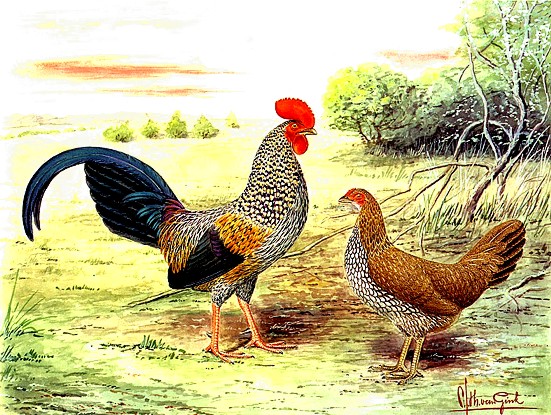
Pierre Sonnerat est un naturaliste et un explorateur français, né le 18 août
1748 et mort le 31 mars 1814. Il est le neveu de Pierre Poivre![]() , botaniste. Il
a fait plusieurs voyages en Asie du Sud-Est notamment afin de pouvoir obtenir
des pieds de végétaux producteurs d'épices, les Hollandais disposant d'un
monopole sur leur commercialisation.
, botaniste. Il
a fait plusieurs voyages en Asie du Sud-Est notamment afin de pouvoir obtenir
des pieds de végétaux producteurs d'épices, les Hollandais disposant d'un
monopole sur leur commercialisation.
Il fait ainsi un voyage en Nouvelle-Guinée, notamment dans les îles Moluques mais aussi de Manille, de 1769 à 1772, à la suite duquel il décrit de très nombreuses espèces végétales et animales (son récit de voyage Voyage à la Nouvelle Guinée paraît en 1776).
De 1774 à 1781, il fait un voyage en Chine. Son compte rendu paraît en 1782
sous le titre de Voyage aux Indes orientales et à la Chine, fait depuis
1774 jusqu'à 1781. Il s'agit d'un ouvrage important pour les Français
car, jusqu'alors, ce sont les Britanniques qui sont les principaux auteurs de
ces voyages. Ses observations sur les peuples autochtones ont un grand intérêt.
La qualité de ses observations n'est pas très bonne et de nombreuses espèces
qu'il décrit ne sont pas reconnaissables. C'est lui toutefois qui décrit le
premier le litchi![]() .
.
Pierre Sonnerat (August 18, 1748 – March 31, 1814) was a French naturalist
and explorer. Sonnerat was the nephew of the botanist Pierre Poivre. He made
several voyages to southeast Asia, visiting the Philippines and Moluccas
between 1769 and 1772, and India and China from 1774 to 1781. He was the first
person to give a scientific description of the south Chinese fruit tree lychee![]() .
He is the person who misinterpreted the call of a helpful Malagasy guide who
had spotted a lemur and shouted "indri!" ("look!" in
Malagasy). Sonnerat took this to be the animal's name, and it is still known
as an Indri today (the actual Malagasy name is babakoto).
.
He is the person who misinterpreted the call of a helpful Malagasy guide who
had spotted a lemur and shouted "indri!" ("look!" in
Malagasy). Sonnerat took this to be the animal's name, and it is still known
as an Indri today (the actual Malagasy name is babakoto).
His books included Voyage
à la Nouvelle-Guinée (1776) and Voyage aux Indes orientales et à la
Chine, fait depuis 1774 jusqu'à 1781 (1782). The standard botanical author abbreviation Sonn. is
applied to plants he described. His name is used in the specific name of the
Grey Junglefowl![]() (Gallus sonnerati).
(Gallus sonnerati).
A true scholar Pierre Sonnerat was against the pervalent racism in the European cycles. During his visits to Asia he marvelled at the rich culture of the Indians. In one of his books Pierre writes "Ancient India gave to the world its religions and philosophies: Egypt and Greece owe India their wisdom and it is known that Pythagoras went to India to study under Brahmins, who were the most enlightened of human beings."
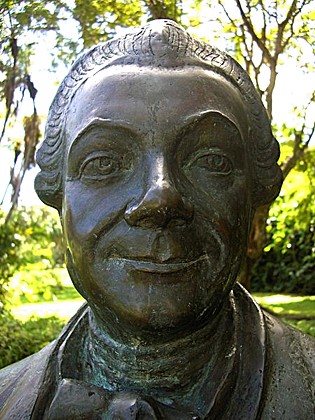
Buste de Pierre Poivre dans le jardin botanique
Sir Seewoosagur Ramgoolam de Pamplemousses
Pierre Poivre, né le 23 août 1719 à Lyon et mort le 6 janvier 1786 dans la même ville, fut un administrateur colonial et agronome français. D'une famille de commerçants modestes, il entre chez les frères missionnaires de Saint-Joseph à la Croix-Rousse. Après de bonnes études, à 21 ans, il part en Chine pour évangéliser Guangzhou (Canton), Macao et Fai-Fo en Cochinchine sans grand succès ni grande conviction. Il est renvoyé en France par ses supérieurs.
Mais son goût de l'aventure est le plus fort. Il rejoint l'Asie à bord d'un navire de la Compagnie française des Indes orientales. Le navire est attaqué par les Britanniques et un boulet de canon lui emporte la main droite. Il est soigné sur le vaisseau britannique mais il doit être amputé du bras. Il est débarqué à Batavia (de nos jours Djakarta) qui est alors un centre important de l'exploitation des épices notamment les noix de muscade et des clous de girofle qui, par leur rareté, représentent une richesse fabuleuse jalousement gardée par les Hollandais. Il se met alors en tête d'acclimater ces espèces à l'île de France (aujourd'hui île Maurice).
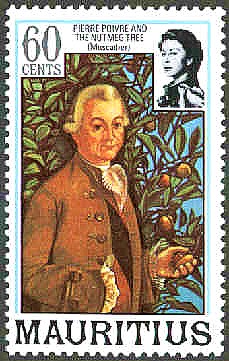
Il rentre alors en France pour défendre son idée auprès de la Compagnie française des Indes orientales mais à la suite d'un naufrage, il embarque sur un navire néerlandais qui est attaqué par un malouin, le malouin est lui aussi attaqué par un Britannique. Poivre est alors enfermé à Guernesey. Il arrive en France en 1748 pour repartir l'année suivante.
Il parvient clandestinement à se procurer des plants de muscadiers et de girofliers qu'il confie à Jean Baptiste Christian Fusée-Aublet (1720-1778) directeur du jardin d'essai de l'île de France puis repart vers les îles Moluques mais ne parvient pas à les atteindre et rejoint le Timor où il réussit à se procurer des muscadiers. À son retour à Maurice, il découvre que ses premières plantations ont dépéri. Quand les nouveaux plants meurent à leur tour, une enquête révèle que c'est Fusée-Aublet lui-même qui a saboté volontairement le travail.
C'est Poivre qui persuade Philibert Commerson d'explorer l'île de France. Il forme également son neveu, Pierre Sonnerat, lequel devient l'assistant de Commerson. Poivre décide alors de rentrer en France. En 1755, il revient à Lyon. Déjà correspondant de l'Académie des sciences auprès d'Antoine de Jussieu, il est reçu à l'Académie des sciences de Lyon et publie ses aventures les Voyages d'un philosophe qui ont du succès. Il épouse Françoise Robin et est anobli par Louis XV.

En 1766 la compagnie de Indes, en faillite, cède ses colonies à la couronne. Poivre est nommé intendant des Mascareignes sur l'île de France, où il crée un des plus beaux jardins botaniques: le jardin de Pamplemousses où il acclimate des plantes des contrées lointaines. Il envoie une nouvelle expédition vers les Moluques qui rapporte alors suffisamment de muscadiers et de girofliers pour mener à bien une acclimatation. Une expédition permettra de varier encore les plants. Poivre ordonne que les plantations ne soient pas limitées à l'île de France. Elles seront disséminées aux Seychelles, sur l'île Bourbon et même en Guyane française. Il quitte l'île de France en 1772 pour rejoindre sa propriété de la Fréta à Lyon où il meurt en 1786.
Son œuvre aurait péricilité, son successeur ayant négligé les plantations si Jean-Nicolas Céré nommé, en 1775, directeur du jardin royal, n'avait opposé la plus ferme résistance à ceux qui en méconnaissaient l'utilité.
Une plaque commémorative a été dévoilée au Château de la Freta à Saint-Romain-au-Mont-d'or en 1994 par l'Association Pierre Poivre de Lyon, présidée par l'écrivain Khal Torabully et Madame Vernazobres. Une allée Poivre sera nommée dans les Dombes en juin 2007.
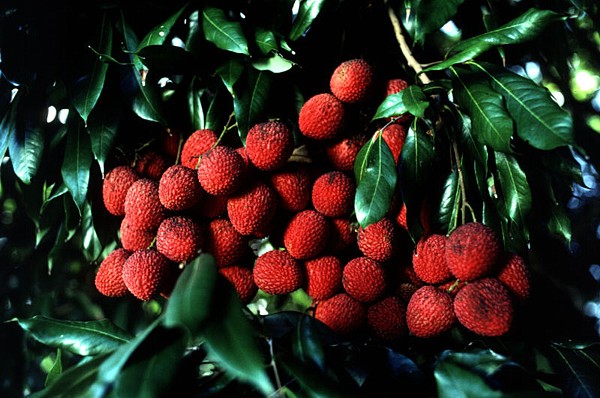
Il Litchi chinensis (litchi o ciliegia della Cina) è il solo membro del genere Litchi nella famiglia delle Sapindaceae. È un frutto tropicale originario del sud della Cina, dell'Indonesia e delle Filippine. Nel Mediterraneo con opportuni accorgimenti può sopravvivere solo nella fascia climatica del limone: Estese e produttive piantagioni esistono in Israele. In Italia ci sono alcune piante adulte in Sicilia, ma sinora il litchi non ha suscitato un interesse a fini commerciali. Potrebbe crescere bene anche nei versanti montani esposti a Sud di Sardegna e Calabria, dove non geli.
Aspetto/varietà: assomigliano a una noce in grandezza e aspetto. Hanno un sottile guscio ruvido rosso e rosa, che si stacca facilmente. La polpa è bianca traslucida succulenta e dolce, con un seme che ricorda quello delle nespole. Il litchi ha un delicato profumo di moscato e rosa. Come scegliere: il frutto deve avere un aspetto fresco e un delicato profumo di rosa. Conservazione: 1 a 2 settimane a temperatura ambiente. Il sapore rimane inalterato anche se il guscio diventa più scuro.
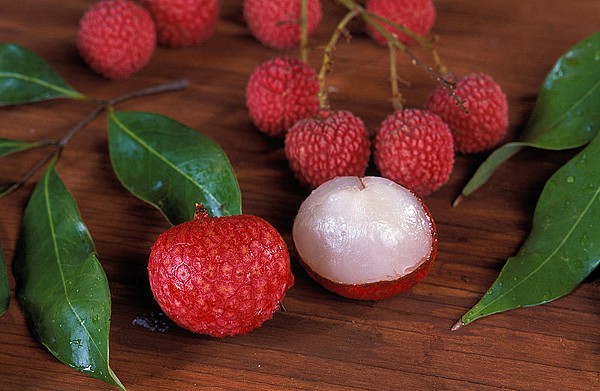
Come consumare: per gustare a pieno il sapore, mangiate il litchi fresco al naturale. Comunque si adatta anche molto bene a numerose ricette, con macedonia, aggiunto ai cocktails di spumante o rhum, in sorbetti. Una ricetta speciale: tagliare un ananas a metà, svuotarlo leggermente tagliando la polpa a dadini. Riempire il guscio di ananas con qualche pallina di sorbetto di litchi, aggiungere la polpa di ananas a dadini, coprire con la meringa (bianco d'uovo montato con zucchero). Mettere in forno per 15 minuti e servire subito.
Proprietà nutrizionali: Valore calorico: 55-60 calorie per 100 grammi. Fra le vitamine è presente in buona quantità la C, buone anche le dosi di sali minerali (calcio, potassio, magnesio e fosforo).
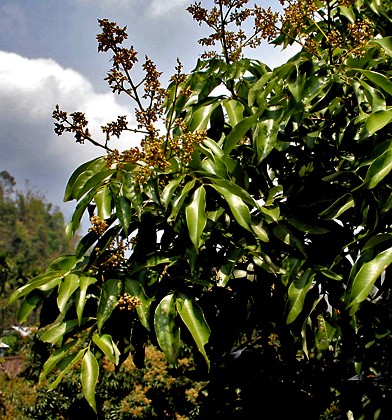
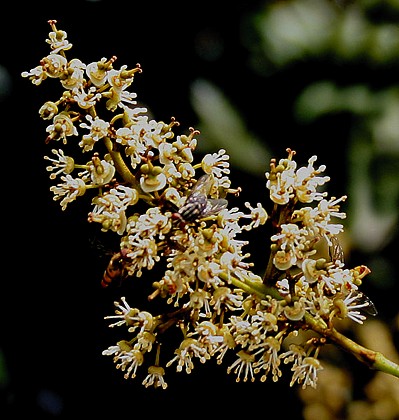
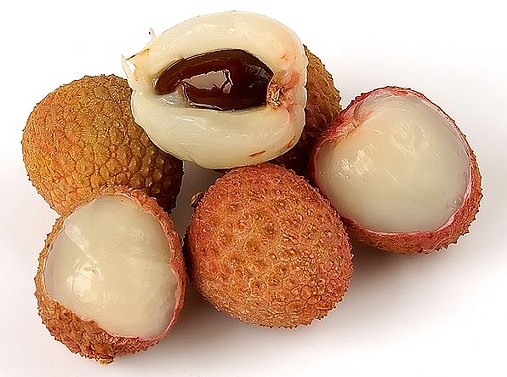
The Lychee (Litchi chinensis), also spelled Litchi (the U.S. FDA spelling) or Laichi and Lichu, Chinese: Hanyu Pinyin: Lìzhi, is the sole member of the genus Litchi in the soapberry family Sapindaceae. It is a tropical fruit tree native to southern China. It is also commonly found in Madagascar, India, Bangladesh, Pakistan, southern Taiwan, northern Vietnam, Indonesia, Thailand, the Philippines, and Southern Africa.
It is a medium-sized evergreen tree, reaching 15–20 m tall, with alternate pinnate leaves, each leaf 15–25 cm long, with 2-8 lateral leaflets 5–10 cm long; the terminal leaflet is absent. The newly emerging young leaves are a bright coppery red at first, before turning green as they expand to full size. The flowers are small, greenish-white or yellowish-white, produced in panicles up to 30 cm long.
The fruit is a drupe, 3–4 cm long and 3 cm in diameter. The outside is covered by a pink-red, roughly-textured rind that is inedible but easily removed. The inside consists of a layer of sweet, translucent white flesh, rich in vitamin C, with a texture somewhat similar to that of a grape. The edible flesh consists of a highly developed aril enveloping the seed. The center contains a single glossy brown nut-like seed, 2 cm long and 1–1.5 cm in diameter. The seed, similar to a buckeye seed, is not poisonous but should not be eaten. The fruit matures from July to October, about 100 days after flowering. There are two subspecies:
Litchi chinensis subsp. chinensis. China, Indochina (Vietnam, Laos and Cambodia). Leaves with 4 to 8 (rarely 2) leaflets.
Litchi chinensis subsp. philippinensis (Radlk.) Leenh. Philippines, Indonesia. Leaves with 2-4 (rarely 6) leaflets.
History
A major early Chinese historical reference to lychees was made in the Tang Dynasty, when it was the favourite fruit of Emperor Li Longji (Xuanzong)'s favoured concubine Yang Yuhuan (Yang Guifei). The emperor had the fruit, which was only grown in southern China, delivered by the imperial messenger service's fast horses, whose riders would take shifts day and night in a Pony Express-like manner, to the capital. (Most historians believe the fruits were delivered from modern Guangdong, but some believe they came from modern Sichuan.)
In the Chinese classical work, Shanglin Fu, it is related that the alternate name, pinyin: lízhi, meaning leaving its branches, is so-called because once the fruit is picked it deteriorates quickly. The lychee was first described in the West by Pierre Sonnerat (1748–1814) on a return from his travel to China and Southeast Asia. It was then introduced to the Réunion Island in by Joseph-François Charpentier de Cossigny de Palma. It was later introduced to Madagascar which has become a major producer.
Cultivation and uses
Lychees are extensively grown in the native region of China, and also elsewhere in South-East Asia, especially in north of Thailand, Laos, Cambodia, Vietnam, Bangladesh, India, southern Japan, Taiwan, and more recently in California, Hawaii, Florida in the United States, the wetter areas of eastern Australia and sub-tropical regions of South Africa, Israel and also in the state of Sinaloa in Mexico. They require a warm subtropical to tropical climate that is cool but also frost-free or with only very slight winter frosts not below -4°C, and with high summer heat, rainfall, and humidity. Growth is best on well-drained, slightly acidic soils rich in organic matter. A wide range of cultivars is available, with early and late maturing forms suited to warmer and cooler climates respectively. They are also grown as an ornamental tree as well as for their fruit.
Lychees are commonly sold fresh in Vietnamese, Chinese and Asian markets, and in recent years, also widely in supermarkets worldwide. The red rind turns dark brown when the fruit is refrigerated, but the taste is not affected. It is also sold canned year-round. The fruit can be dried with the rind intact, at which point the flesh shrinks and darkens. According to folklore, a lychee tree that is not producing much fruit can be girdled, leading to more fruit production.
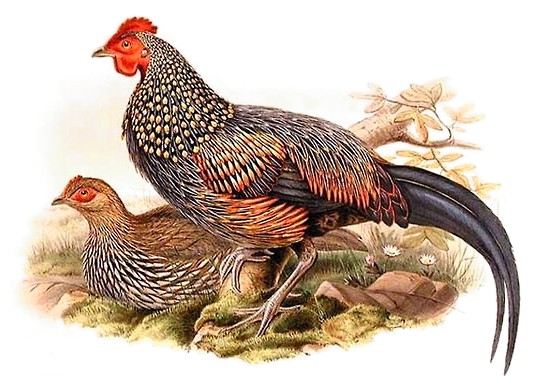
The
Grey Junglefowl Gallus sonnerati
also known as Sonnerat's Junglefowl
is a wild relative of domestic fowl found in India
The male has a black cape with ochre spots and the body plumage on a grey ground colour is finely patterned. The elongated neck feathers are dark and end in a small, hard, yellowish plate; this peculiar structure making them popular for making high-grade artificial flies. The legs are red and the wattles and combs are not as strongly developed as in the Red Junglefowl. Legs of males have spurs and females usually lack them. The central tail feathers are long and sickle shaped. Males have an eclipse plumage in which they moult their colourful neck feathers in summer during or after the breeding season. The female is duller and has black and white streaking on the underparts and yellow legs. They are found in thickets, on the forest floor and open scrub. Their loud calls of Ku-kayak-kyuk-kyuk can be heard in the early mornings and at dusk. They forage in small mixed or single sex groups.
They breed from February to May. They lay 4 to 7 eggs which are pale creamy in a scrape. Eggs hatch in about 21 days. Although mostly seen on the ground, Grey Junglefowl fly into trees to escape predators and to roost. They feed on grains including bamboo seeds, berries, insects and termites.
The species epithet commemorates the French explorer Pierre Sonnerat. Local names include Komri in Rajasthan, Geera kur or Parda komri in Gondi, Jangli Murghi in Hindi, Raan kombdi in Marathi, Kattu Kozhi in Tamil and Malayalam, Kaadu koli in Kannada and Tella adavi kodi in Telugu.
The species is mainly in the Indian Peninsula but extends into Gujarat, Madhya Pradesh and south Rajasthan. This species and the Red Junglefowl overlap slightly along the northern boundary of the distribution although the ranges are largely non-overlapping. Some geneticists suggest that the bird may have been crossbred with the Red Junglefowl to form the modern domesticated chicken.
The Grey Junglefowl is found mostly in Peninsular India, while the Red Junglefowl is found more along the foothills of the Himalayas. A region of overlap occurs in the Aravalli range. The species has been isolated by a variety of mechanisms including behavioural differences and genic incompatibility. Some phylogenetic studies of Junglefowl show that this species is more closely related to the Ceylon Junglefowl Gallus lafayettei than to the Red Junglefowl, Gallus gallus, but another study shows a more ambiguous position due to hybridization. An endogenous retroviral DNA sequence, of the EAV-HP group noted in domestic fowl is also found in the genome of this species pointing to the early integration of the virus DNA into the genome of Gallus.
A study in southern India found a density of 19.8 groups per square kilometer (but ranging from 1.67 to 34.42 in dry deciduous forests on plains) with an average group size of 1.3. The male to female ratio was 1:1.2 and the preferred habitat was low to moderate canopied forest with low or no grass cover. They are threatened by hunting for food and habitat loss. Feather use in fly-fishing has also been suggested as a threat.